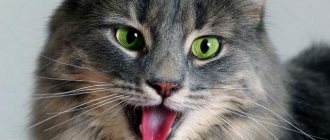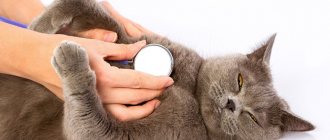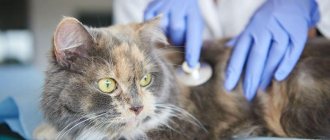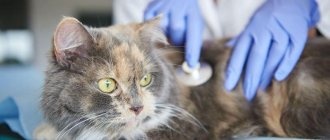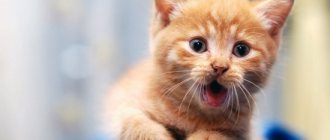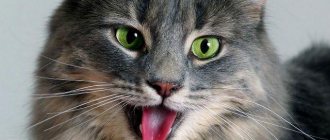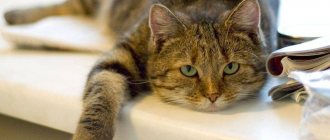Physiological reasons
In cats, as in humans, breathing through the nose is considered the physiological norm. It is not uncommon to see a cat breathing with its mouth open and its tongue hanging out like a dog. It is noticeable that with this method of breathing the abdominal muscles are involved: the cat breathes not from the chest, but from the stomach.
Nature has created a vacuum in the chest cavity around the lungs. When the pectoral muscles work while inhaling, the ribs diverge - the lungs straighten and fill with air, which enriches the blood with oxygen.
If there is a lack of oxygen, an “emergency” breathing mode is activated and the abdominal muscles are activated. The body tries to increase the amount of air inhaled - it increases breathing movements.
As soon as the oxygen level in the blood returns to normal, abdominal breathing “turns off” - the cat breathes calmly, through the chest, through the nose. If the animal does not have any pathological changes in the body, such conditions correspond to the norm and quickly pass when the negative factor is eliminated.
Natural external reasons why a cat breathes with its mouth open are:
- Hot. It is known that as the air temperature rises, the oxygen content decreases. The body's need for this element increases. The brain introduces a mode of “enhanced ventilation” - breathing becomes more frequent. Long-haired cats have a particularly hard time withstanding the heat: Maine Coons, Persians, Siberians. The owner's job is to keep the animal cool.
- Rapid breathing is often observed in cats that are obese. If a cat has suddenly gained weight, then you can often observe that the animal is breathing heavily with its mouth open. After the body adapts to the extra load or returns to normal (which is preferable), these phenomena disappear.
- After increased physical activity. Kittens are especially susceptible to this. Kids do not yet know how to regulate the load and after playing they get so tired that they “lay around without their hind legs” and often breathe with their mouths open and stick out their tongues. If the kitten breathes with an open mouth, then the reason for this may be irrepressible running and active play.
- Generic activity. During contractions and pushing, the uterus contracts, which limits the supply of oxygen to the organ. To avoid hypoxia in newborn kittens, the mother's body turns on increased breathing to protect the babies from suffocation. In this case, this is a necessary measure.
- The first time after giving birth and while feeding kittens, the cat may breathe rapidly with its mouth open, this is normal.
- Sexual hunting. During this period, the endocrine system of cats works in active mode: increased releases of sex hormones into the blood occur. Increased activity of the endocrine glands requires more oxygen - cats breathe frequently.
- Stressful situations. By frequent, heavy breathing with an open mouth, the animal’s body responds to psychological discomfort.
When these causes are eliminated, the cat quickly restores normal respiratory activity.
Heart failure
Listed above are all the main possible reasons when a dog is breathing frequently. But the most common disease is heart failure. We'll tell you about it in more detail. All heart diseases can be divided into three groups:
- congenital;
- acquired;
- age.
Congenital defects are more common in young pets. Very often in this case, animals die, since the body is still quite weak. Acquired defects, as a rule, occur in middle-aged animals, and age-related defects occur in animals older than eight years. In addition to rapid breathing, heart disease may cause other symptoms in pets.
Small dogs stop playing, sleep longer, and do not gain weight at all due to the fact that they do not eat well.
Adults may experience shortness of breath even at rest. The dog is very lethargic and may faint during a quiet walk. There is a possibility of rapid weight gain due to high water consumption.
All of these symptoms are causes of heart problems in your pet. This can also include unsteady gait, weakness, and refusal to eat.
If rapid breathing is a sign of heart disease, you should switch your pet to feeding in small portions, and also reduce the amount of physical activity and walks. The doctor must prescribe special medications. They should be taken exactly as directed.
Pathological causes
Rapid breathing with an open mouth and protruding tongue indicates a lack of air in the cat’s body - oxygen starvation. If the natural causes of this condition have been eliminated, and the cat continues to breathe too quickly, do not hesitate, you need to show the animal to a specialist.
The reason for this may be dangerous pathological conditions.
Pulmonary edema
When they talk about pulmonary edema, they mean excessive accumulation of fluid in the tissues of the organ. This is not an independent disease, but a symptom. In cats, pulmonary edema can develop for two reasons: cardiogenic (edema is provoked by some kind of cardiac pathology) and non-cardiogenic - caused by external influences.
Non-cardiogenic causes:
- hot air entering the respiratory tract;
- reaction to medications, including anesthesia;
- allergy;
- consequences of pneumonia or asthma;
- food poisoning or inhalation of toxic fumes;
- renal failure;
- head injury with damage to the brain and its membranes;
- blood poisoning;
- sun, heatstroke or electric shock.
Pulmonary edema develops very quickly, and if urgent rescue measures are not taken, the cat may die. This condition has pronounced symptoms and is easy to identify:
- the cat suddenly loses strength and stops responding to external stimuli;
- it is noticeable that the animal is having difficulty breathing;
- the animal coughs, breathes with its mouth slightly open, sticks out its tongue;
- mucous membranes rapidly turn pale, subsequently acquiring a bluish tint;
- when coughing, pinkish sputum appears - the result of injury to the alveoli;
- the initially rapid heartbeat weakens and becomes intermittent;
- As a result of impaired peripheral circulation, the cat's paws become cold.
Accumulation of fluid or air in the chest cavity
In case of injuries that are accompanied by damage to the skin and muscle frame or rib fractures, air can enter the cat's chest cavity. It prevents the lungs from fully expanding when inhaling. This condition is called pneumothorax.
Also, as a result of injury or internal bleeding, blood can enter the chest cavity. With various pathological conditions, there may be an accumulation of other body fluids, which interferes with the normal functioning of the cat’s lungs. This condition is called hydrothorax.
A cat can get rib fractures and penetrating wounds if it falls from a height or receives a strong blow. Only a veterinarian can determine what happened to the cat and why he is breathing with his mouth open. In case of injury, you should carefully lay the animal on its side, keep it still and urgently take it to the clinic.
State of shock
Shock is a common cause of sudden hypoxia. The threatening condition develops at lightning speed, and the following situations are the reason for its occurrence:
- injury;
- poisoning;
- allergic reaction;
- long-term infectious disease.
It is possible to bring a cat out of a state of shock only in a veterinary clinic. And if it is possible to get a shock in seconds, then getting out of it can take several days.
Foreign body in the respiratory tract
If during a meal the cat stops eating and begins to snort and cough, opens its mouth, you should watch it. Perhaps a piece of food got into the respiratory tract. He will come out soon and nothing bad will happen.
Also, during play, a small object may get into the cat’s throat.
If the cough does not stop, and wheezing is heard when breathing, and inhalation and exhalation become intermittent, do not hesitate! Probably, the foreign body has penetrated deep into the respiratory tract and can completely block it.
It is strictly forbidden to shake, turn over or slap your pet on the back or other parts of the body if the cat begins to breathe with its mouth open. These measures are unlikely to help, and are quite likely to do harm. Only a specialist can cope with the problem.
Heart diseases
Rapid and heavy breathing after games or long walks is quite normal if it is short-lived and the pet recovers quickly. If a cat breathes with her mouth open too often, and even without any particular reason, this is a cause for concern.
The appearance of a bluish tint to the tongue and oral mucosa is an alarming signal.
These signs indicate the development or presence of heart failure. Hypoxia is an inevitable companion to pathologies of cardiac activity. Urgent consultation with a feline cardiologist is necessary. The sooner the owner shows the cat to the doctor, the greater the chance of preserving the health and life of the pet.
Scottish cats, Maine Coons, Abyssinians, Orientals, Cornish Rexes and Sphynxes are especially predisposed to heart pathologies.
Other pathologies
There are a number of congenital pathologies and mechanical damage that lead to the fact that the cat is forced to breathe with his mouth open:
- pathology in the structure or damage to the spinal cord;
- brain tumors that affect the respiratory center;
- helminthic infestations: some endoparasites lay eggs in the lungs;
- respiratory diseases (bronchitis, tracheitis);
- congenital pathologies of the oral cavity.
Video: pulmonary edema in a cat - main symptoms and causes
Many dog owners sometimes notice that their dog is breathing rapidly. This can be considered a completely normal phenomenon, but it can also indicate serious illness. To determine what this is connected with, it is necessary to take into account some features. The normal breathing rate for dogs is 10-30 breaths per minute. To determine the number of breaths, you need to place your hand on your pet’s chest and time it for one minute.
Your dog's breathing may change frequently throughout the day. If nothing bothers the pet, then he breathes through his nose and calmly. But if the dog does this with his mouth, then this action is not always a cause for concern.
First aid
In addition to the above private signs, the cat owner’s anxiety and concern should be caused by the following symptoms, common to all conditions that threaten the pet’s life:
- the cat is apathetic and lethargic;
- frequent vomiting;
- cough is dry or with bloody sputum;
- the cat shows signs of anxiety and fear.
If these symptoms are present in addition to difficulty breathing, the most effective help for your pet will be to take him to the clinic as soon as possible or call a doctor at home. During transportation or while waiting for help, the cat should be placed on its side and, if possible, its mobility should be limited.
It should be remembered that you cannot hesitate and waste time. Prolonged hypoxia entails irreversible changes in the brain, which will lead to the death of the pet.
How to deliver a pet to a medical facility?
If there is a need to go to a specialized institution, you should follow the rules for transporting the animal. If the pet is unconscious, then during transportation it should be placed on its right side, with its neck and tongue extended.
If the animal is in a conscious state, it has all the signs of vital activity, it must be transported in a special basket or cardboard box, the bottom of which must be lined with something soft. Ideally, he should be accompanied by the owner.
It is worth noting that many modern veterinary clinics are equipped with ambulance services. Therefore, if the pet’s condition is extremely serious, then it is better to use just such a service.
Breathing through the mouth for a cat is not physiological and characteristic. Most often it occurs as a result of certain pathological conditions, which can be quite dangerous and lead to tragic consequences. For this reason, you need to immediately determine why exactly this is happening. Timely, correctly provided assistance will make it possible to maintain health, and sometimes even the life of a pet depends on it. A loving owner must understand that not in all cases it is possible to solve the problem on your own, especially in difficult situations. For this reason, the best option is qualified assistance in a veterinary hospital, where the cat will have to be transported independently in a carrier or in a cardboard box.
If it is not possible to immediately deliver the cat to the clinic for diagnosis, then you can use a telephone consultation. Many modern specialized organizations provide the service of visiting a veterinarian at home. This makes it possible to provide assistance to animals in the most urgent and unforeseen situations that require the use of emergency measures aimed at saving the pet.
Treatment and prognosis
Treatment is prescribed after examination and diagnosis. Depending on the reasons that caused the breathing disorder, appropriate medical procedures will be carried out with the cat.
The doctor’s first task will be to eliminate hypoxia. For this purpose, if necessary, the cat will be connected to an artificial lung ventilation device (ALV). The animal is also given drugs intravenously that enrich the blood with oxygen.
Next, after the necessary hardware tests, the cause of suffocation is eliminated. Often it is necessary to resort to surgical intervention.
The prognosis for the pet’s recovery depends on the owner’s responsibility and effective actions. The faster the cat receives effective help, the more favorable the prospects for his recovery. It all depends on the severity of the animal’s condition at the time of treatment at the clinic.
When cats breathe with their mouths open too often without a “good reason,” this should alert the owner and prompt them to consult a professional. Even a congenital disease can be taken under control and exacerbations prevented. This way you can extend the life of your family pet and make it more enjoyable.
Diagnostics
To understand why an animal opens its mouth when breathing, it is necessary to closely monitor it for several days. This will help your veterinarian determine the exact cause. In this case, you should pay attention:
- On the general condition of the cat, appetite, activity, trips to the toilet and stool consistency.
- Is this condition accompanied by vomiting or coughing?
- After which this phenomenon occurs, perhaps it is preceded by active games or other physical activity.
- How often does this happen - constantly or at regular intervals?
In any case, with this symptom, contacting a veterinary institution is mandatory. The doctor will conduct an in-person examination and collect anamnesis, and will prescribe appropriate diagnostic measures, which include:
- Blood sampling for general and biochemical analysis.
- Chest X-ray.
- Electrocardiogram of the heart.
- Ultrasonography.
- Diagnosis of infectious diseases.
- Bronchoscopy and rhinoscopy.
- Consultations for the presence of tumor formations of the respiratory system.
Functional brain disorders
Veterinarians identify the causes that lead to disruption of the brain and nervous system:
The above reasons lead to a lack of coordination: the cat cannot independently control movements or control muscles. So he sticks out his tongue.
Veterinarians offer a small test that helps make sure that your cat has no neurological problems. If the animal sticks out its tongue, you need to touch it a little. If there are no neurological problems, the cat will quickly hide its tongue. If the actions do not bring results, we can talk about a pathological signal from the body.
How to give artificial respiration to a cat
1. Place the animal on the floor. The neck and spine should form a straight line.
2. Clean the cat’s mouth from secretions with a napkin and close his mouth.
3. Place your palm in a tube, apply it to the animal’s nose, and exhale air there (you can inhale directly into the nose, covering the mouth with a handkerchief).
Frequency – approximately 20 times per minute for medium-sized cats (the smaller the pet, the more often). Monitor the intensity of exhalation so as not to damage the cat’s lungs (this is especially true for kittens). To do this, hold your hand on the cat's chest - with a suitable volume of air, it will only expand slightly.
4. Feel your pulse every 20 seconds. If it suddenly stops, you need to try to restore the heartbeat with indirect massage. With one hand, take the cat's chest, pinching it between your thumb and the other four fingers, and quickly squeeze and release 5 times. After this, exhale 1 air into the cat’s nose, then squeeze again.
The respiratory system of cats is naturally very vulnerable, so the only right thing to do if a cat is breathing heavily is to immediately take him to a veterinary clinic, where he will receive qualified assistance. Among the many diseases whose symptoms include shortness of breath, there are none that you can cure on your own.
The article was read by 2,663 pet owners
Heat
The main physiological reason why a cat sticks out its tongue is temperature regulation. The animal protrudes the organ to reduce discomfort, for example, during heat. This prevents the development of heat stroke. In this case, the owner should take the cat to a cool place and pour water on it.
But a cat's tongue sticking out can also be a signal of high body temperature. To understand whether your pet is suffering from heat or is sick, you need to figure out what temperature is considered normal in cats.
The normal temperature for a cat is 38-39 degrees. But don’t panic right away if the indicator deviates slightly from the norm. Here are the common reasons for the thermometer to shift:
If the temperature rises due to illness, you should not self-medicate - the animal should be taken to the veterinarian.
